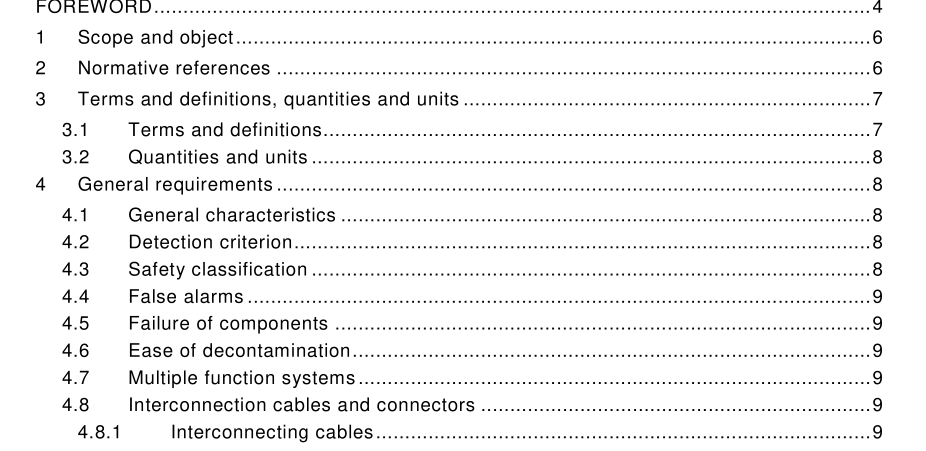IEC 60860-2014 pdf Radiation protection instrumentation – Warning equipment for criticality accidents

4 General requirements 4.1 General characteristics Criticality alarm systems are designed for the automatic and prompt detection of gamma radiation or neutrons from a criticality accident and to actuate immediate evacuation and warning alarms. The primary functions of the criticality alarm system shall be to: – detect a criticality accident as soon as it occurs within the monitoring zone of the detector(s); – actuate an alarm with minimal delay; – achieve a high degree of reliability required by its safety classification and low probability of false alarm; – fail safe by design and reveal failures (single failure shall be indicated but shall not disable the system and result in a potential non-detection of a criticality accident); – be secured against unauthorised adjustment. Secondary functions of the criticality alarm system should be established by agreement between the manufacturer and user. A recommended secondary function should include the ability to measure radiation levels during and following a criticality accident. It shall be possible to test the response and performance of the criticality alarm system without causing personnel evacuation. 4.2 Detection criterion The following detection criterion definition described in ISO 7753 is used. Criticality alarm systems shall be designed to detect promptly the minimum accident of concern. For this purpose, in typical unshielded process areas, the minimum accident may be assumed to deliver an equivalent absorbed neutron and gamma dose in free air of 0,2 Gy at a distance of 2 m from the reacting material within 60 s. Very slowly increasing excursions, while unlikely to occur, may not attain this value. Furthermore, excursions in unmoderated systems will probably occur much more rapidly. In the design of radiation detectors, it may be assumed that the minimum duration of the radiation transient is 1 ms FWHM (Full Width Half Maximum).
4.4 False alarms Particular consideration shall be given, during the design of the criticality alarm system, to minimize false alarms. A redundant system, requiring response from at least two detector channels out of three (2OO3) is one of the methods used in minimising false alarms. If a redundant system is used, alarm or failure of any single channel shall not activate the alarm or render the criticality alarm system inoperative. A warning signal of a detected malfunction shall be provided in this case and the system shall continue to operate as a one out of two (1 OO2) redundant system using the remaining healthy channels. The maintenance requirements shall be kept to the minimum practicable and the equipment shall be designed to facilitate maintenance without causing false alarms.
- ISO IEC 27050-4-2021 pdf Information technology — Electronic discovery — Part 4: Technical readiness
- ISO IEC 27036-1-2021 pdf Cybersecurity — Supplier relationships — Part 1: Overview and concepts
- ISO IEC 27013-2021 pdf Information security, cybersecurity and privacy protection — Guidance on the integrated implementation of ISO/IEC 27001 and ISO/IEC 20000-1
- ISO IEC 26580-2021 pdf Software and systems engineering — Methods and tools for the feature- based approach to software and systems product line engineering
- ISO IEC 24735-2021 pdf Information technology — Office equipment — Method for measuring digital copying productivity
- ISO IEC 24711-2021 pdf Information technology — Office equipment — Method for the determination of ink cartridge yield for colour inkjet printers and multi- function devices that contain printer components
- ISO IEC 23544-2021 pdf Information Technology — Data centres — Application Platform Energy Effectiveness (APEE)
- ISO IEC 23510-2021 pdf Information technology — 3D printing and scanning — Framework for an Additive Manufacturing Service Platform (AMSP)
- ISO IEC 23127-1-2021 pdf Information technology — Learning, education, and training — Metadata for facilitators of online learning — Part 1: Framework
- ISO IEC 23126-2021 pdf Information technology for learning, education and training — Ubiquitous learning resource organization and description framework
- IEC 62830-5-2021 pdf Semiconductor devices – Semiconductor devices for energy harvesting and generation – Part 5: Test method for measuring generated power from flexible thermoelectric devices
- IEC 62271-112-2013 pdf High-voltage switchgear and controlgear – Part 112: Alternating current high-speed earthing switches for secondary arc extinction on transmission lines
- IEC 61255-2014 pdf Household electric heating pads – Methods for measuring performance
- ISO IEC 29121-2013 pdf Information technology — Digitally recorded media for information interchange and storage — Data migration method for DVD-R, DVD-RW, DVD-RAM, +R, and +RW disks
- IEC 60794-1-403-2021 pdf Optical fibre cables – Part 1-403: Generic specification – Basic optical cable test procedures – Electrical test methods – Electrical continuity test of cable metallic elements, method H3
- BS ISO IEC 15420-2009 pdf Information technology一 Automatic identification and data capture techniques EAN/UPC bar code symbology specification
- BS IEC 60860-2014 pdf Radiation protection instrumentation一 Warning equipment for criticality accidents
- BS ISO IEC 19762.5-2008 pdf Information technology一 Automatic identification and data capture (AIDC) techniques – Harmonized vocabulary Part 5: Locating systems
- ISO IEC 24735-2021 pdf Information technology — Office equipment — Method for measuring digital copying productivity
- ISO IEC 24711-2021 pdf Information technology — Office equipment — Method for the determination of ink cartridge yield for colour inkjet printers and multi- function devices that contain printer components